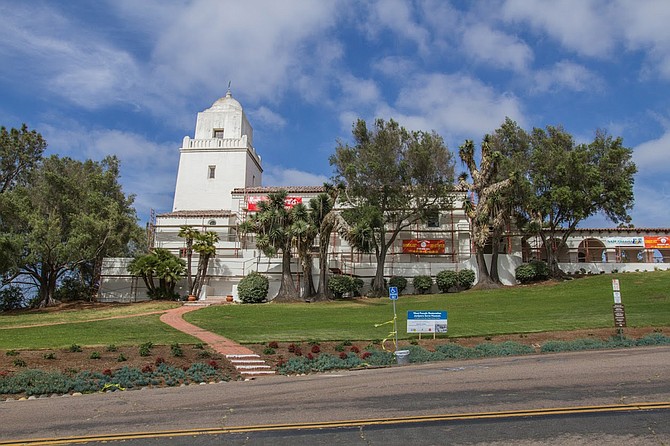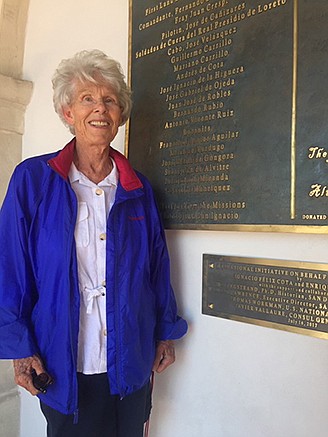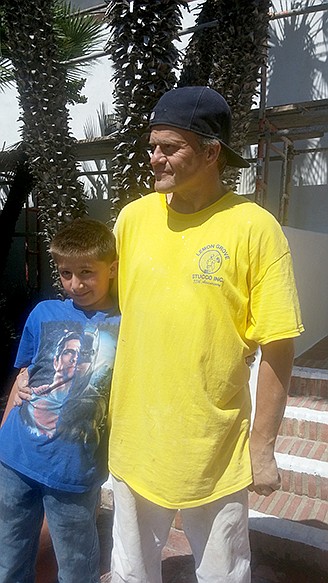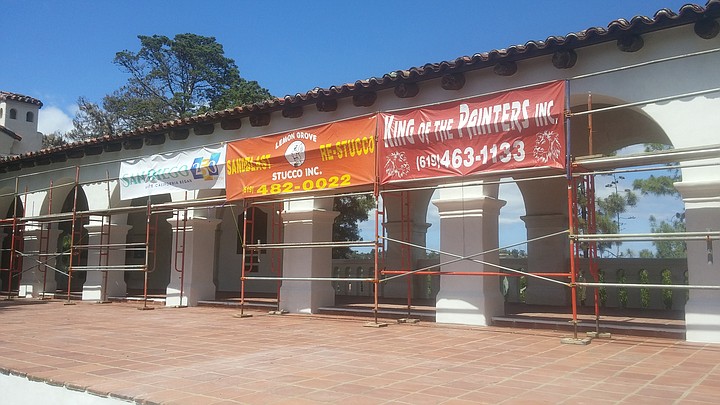 Facebook
Facebook
 X
X
 Instagram
Instagram
 TikTok
TikTok
 Youtube
Youtube

Almost five years ago, Bill Lawrence, president of the San Diego History Center, went to Los Angeles to accept an award from the California Preservation Foundation. The purpose of the award was to honor the excellence of a document called the “Junipero Serra Museum: Historic Structure Report.” The center had commissioned the local group Heritage Architecture and Planning to write a report outlining the planned preservation “improvements for the museum in San Diego’s Presidio Park.”

The report came in at 140 glossy pages with a picture of the museum on its cover. Any San Diegan who has driven through the I-5 and I-8 intersection would recognize it as the striking building visible from the freeways on the hill above Old Town.

According to Lawrence, the report cost $50,000. It pinpointed numerous “fair” and “poor” exterior conditions that were evident on the museum’s exterior in 2014. It doesn’t devote nearly as much attention to the interior, which it deems “generally good.” At least one of the most serious defects the report notes, “a damaged balcony on the north wall of the tower,” is judged to be “hazardous.” “Damaged balcony balustrades on the upper tower,” and “areas of cracked and spalling concrete on the exterior tower walls” are labeled “potentially hazardous.” Attention is called to a “fall hazard on the west side of the main terrace.” Additionally, the report cites many cracks in walls, peeling paint on wood windows and doors, missing light fixtures, plumbing problems and other issues.
The importance of addressing the poor conditions has been especially highlighted by the approaching 250th anniversary of the Spanish expedition that began what became known as San Diego and the state of California. On July 16, 1769, Gaspar de Portola arrived overland from Loreto in Baja and began building a settlement and then a military fortification the Spanish called El Presidio Real de San Diego. Portola was accompanied by the Franciscan friar Junipero Serra. The new settlement became the base for further exploration north, resulting in presidios at what are now Santa Barbara, Monterey, and San Francisco and Serra’s many California missions.
Five years would have been plenty of time to prepare for a commemoration of the first European settlement on the West Coast that is now to occur at the museum on July 16, 2019. Its theme will be “Honor our Past, Look to the Future Together.” During the ceremony, a new Kumeyaay Nation flag will be raised to join the American, Mexican, and Spanish flags.

The 200th anniversary was celebrated at the museum in 1969. Iris Engstrand, professor emerita of history at USD, played a key role in planning that event.
“I was a brand new member of USD’s history department at the time,” Engstrand tells me, “so the rest of the faculty designated me to run around town to help organize the celebration.”
Both the museum and Presidio Park on the hill below it were financed and donated to the city of San Diego by philanthropist George Marston. Marston hired architect William Templeton Johnson, who used Spanish revival architecture to design the building, which went up in 1928.
Engstrand and I visited the museum grounds in early June, and I asked her how many of the repairs recommended in the Historic Structure Report have been completed to date.
“Not a single one,” she says.
On a subsequent visit, I saw a huge re-plastering and repainting effort had begun. According to Bill Lawrence, the job is costing $300,000. How recently did it start? Scott, one of the workers who have been re-plastering and repainting the Serra’s exterior, estimated that it must have started a week or two earlier, making it approximately June 10 to 17.
Contractors have been working only on the museum’s west facade. Initially, cleaning and painting the building’s backside and its tower will have to wait. From the ground it is easy to see the tower’s black splotches of mold. But Scott, who is there on a Saturday hauling equipment out with his nephew Rook, tells me he learned the History Center wants to finish the tower before the July 16 celebration, along with the lower facade. “I hate working at heights,” he says. “I get shaky.” He’s not worried for now, though. “With all the other work my boss already has lined up, we won’t be able to get it done in that time.”
Whatever preservation can be accomplished in the eleventh hour will help the Serra look presentable for the July 16. But Iris Engstrand is critical of the city’s long neglect of the building. “I have been agitating for a long time for better care to be taken of the museum,” she says.
Engstrand stepped away a few years ago from working at the History Center as a curator. She took a turn editing its Journal of San Diego History, but resigned this past spring. Her strong commitment to the Serra has been influenced largely by her academic specialty, the history of Spain. She has written a history of San Diego and other books. She retired from teaching at the University of San Diego five years ago.
It has been lack of money that has most hindered the Serra’s upkeep. It is only open a few hours Friday through Sunday, so the museum doesn’t receive a lot of visitors, and access to it is not easy. Two narrow wings of Presidio Drive separate from each other a block in from its intersection with Taylor Street in Old Town. The two forks then wind up the hill on either side of the park. The northern route emerges into a spacious parking lot, but elderly or handicapped visitors then face a substantial flight of stairs to reach the museum (no Americans with Disabilities Act accommodations have been installed). And after the southern route of Presidio Drive reaches the top of the hill, the road goes on a long run through the park, revealing no clearly defined path leading to the museum.
The city still owns both the Serra Museum and the park, while the History Center, a non-profit, leases the museum building. The city is thus as much on the hook for supporting the Serra as it is for its support of Balboa Park and its attractions.
On June 14, former city councilwoman and current state senator Toni Atkins revealed she had obtained from the state budget $8.2 million for the Botanical Building renovation in Balboa Park and $9 million for the restoration of Liberty Station’s Building 178.
The announcement struck a nerve in those dedicated to restoration of the Serra. Tom Workman, who retired as superintendent of the Cabrillo National Monument four years ago, wrote on June 21 to the editor of the San Diego Union-Tribune: “How come [the state and city can support Liberty Station and Balboa Park] but neither one can spare even $180,000 to finish painting the city owned Serra Museum — the iconic structure marking the place where the city is commemorating its poorly advertised 250th anniversary on July 16.”
By phone I reach Workman at his new home in Borrego Springs. He tells me that after unsuccessfully approaching San Diego Parks and Recreation with concerns he had several years ago, he wrote to the California Register of Historical Resources to complain about Mayor Kevin Faulconer’s lack of commitment to the Serra Museum and Presidio Park. A few days later, he says Bruce Martinez, then assistant director of the parks department, contacted him for a meeting. But the meeting seemed designed only to disabuse Workman of his hopes. “In fact,” he says, “Martinez told me he’d never been to Presidio Park.”
Is there a contemporary perception that the Presidio and the Serra Museum are insignificant historical resources? Workman and Engstrand argue that there shouldn’t be. “What happened in the 1769 Spanish settlement in San Diego was the most consequential historical event ever in the region,” says Engstrand. It was the germ from which San Diego and the state of California were born.
But the San Diego Tourism Authority hasn’t gotten the message. On June 28, in a mass emailing it labeled as “Go Big in San Diego,” it recommended seven attractions visitors should consider. Of course, Balboa Park and SeaWorld were included but not Presidio Park and the Serra Museum.
The July 16 commemoration is free and open to the public. Mayor Faulconer is inviting many local notables to the evening celebration, plus Toni Atkins, Assemblyman Todd Gloria, and Governor Gavin Newsom. Although its previous track record has not been good, the city is promising that the hoi poloi will be able to enjoy a fully renovated Serra Museum by the end of the year.
In response to the Tourism Authority’s list, Iris Engstrand emailed me, “They forgot their birthday.”


Almost five years ago, Bill Lawrence, president of the San Diego History Center, went to Los Angeles to accept an award from the California Preservation Foundation. The purpose of the award was to honor the excellence of a document called the “Junipero Serra Museum: Historic Structure Report.” The center had commissioned the local group Heritage Architecture and Planning to write a report outlining the planned preservation “improvements for the museum in San Diego’s Presidio Park.”

The report came in at 140 glossy pages with a picture of the museum on its cover. Any San Diegan who has driven through the I-5 and I-8 intersection would recognize it as the striking building visible from the freeways on the hill above Old Town.

According to Lawrence, the report cost $50,000. It pinpointed numerous “fair” and “poor” exterior conditions that were evident on the museum’s exterior in 2014. It doesn’t devote nearly as much attention to the interior, which it deems “generally good.” At least one of the most serious defects the report notes, “a damaged balcony on the north wall of the tower,” is judged to be “hazardous.” “Damaged balcony balustrades on the upper tower,” and “areas of cracked and spalling concrete on the exterior tower walls” are labeled “potentially hazardous.” Attention is called to a “fall hazard on the west side of the main terrace.” Additionally, the report cites many cracks in walls, peeling paint on wood windows and doors, missing light fixtures, plumbing problems and other issues.
The importance of addressing the poor conditions has been especially highlighted by the approaching 250th anniversary of the Spanish expedition that began what became known as San Diego and the state of California. On July 16, 1769, Gaspar de Portola arrived overland from Loreto in Baja and began building a settlement and then a military fortification the Spanish called El Presidio Real de San Diego. Portola was accompanied by the Franciscan friar Junipero Serra. The new settlement became the base for further exploration north, resulting in presidios at what are now Santa Barbara, Monterey, and San Francisco and Serra’s many California missions.
Five years would have been plenty of time to prepare for a commemoration of the first European settlement on the West Coast that is now to occur at the museum on July 16, 2019. Its theme will be “Honor our Past, Look to the Future Together.” During the ceremony, a new Kumeyaay Nation flag will be raised to join the American, Mexican, and Spanish flags.

The 200th anniversary was celebrated at the museum in 1969. Iris Engstrand, professor emerita of history at USD, played a key role in planning that event.
“I was a brand new member of USD’s history department at the time,” Engstrand tells me, “so the rest of the faculty designated me to run around town to help organize the celebration.”
Both the museum and Presidio Park on the hill below it were financed and donated to the city of San Diego by philanthropist George Marston. Marston hired architect William Templeton Johnson, who used Spanish revival architecture to design the building, which went up in 1928.
Engstrand and I visited the museum grounds in early June, and I asked her how many of the repairs recommended in the Historic Structure Report have been completed to date.
“Not a single one,” she says.
On a subsequent visit, I saw a huge re-plastering and repainting effort had begun. According to Bill Lawrence, the job is costing $300,000. How recently did it start? Scott, one of the workers who have been re-plastering and repainting the Serra’s exterior, estimated that it must have started a week or two earlier, making it approximately June 10 to 17.
Contractors have been working only on the museum’s west facade. Initially, cleaning and painting the building’s backside and its tower will have to wait. From the ground it is easy to see the tower’s black splotches of mold. But Scott, who is there on a Saturday hauling equipment out with his nephew Rook, tells me he learned the History Center wants to finish the tower before the July 16 celebration, along with the lower facade. “I hate working at heights,” he says. “I get shaky.” He’s not worried for now, though. “With all the other work my boss already has lined up, we won’t be able to get it done in that time.”
Whatever preservation can be accomplished in the eleventh hour will help the Serra look presentable for the July 16. But Iris Engstrand is critical of the city’s long neglect of the building. “I have been agitating for a long time for better care to be taken of the museum,” she says.
Engstrand stepped away a few years ago from working at the History Center as a curator. She took a turn editing its Journal of San Diego History, but resigned this past spring. Her strong commitment to the Serra has been influenced largely by her academic specialty, the history of Spain. She has written a history of San Diego and other books. She retired from teaching at the University of San Diego five years ago.
It has been lack of money that has most hindered the Serra’s upkeep. It is only open a few hours Friday through Sunday, so the museum doesn’t receive a lot of visitors, and access to it is not easy. Two narrow wings of Presidio Drive separate from each other a block in from its intersection with Taylor Street in Old Town. The two forks then wind up the hill on either side of the park. The northern route emerges into a spacious parking lot, but elderly or handicapped visitors then face a substantial flight of stairs to reach the museum (no Americans with Disabilities Act accommodations have been installed). And after the southern route of Presidio Drive reaches the top of the hill, the road goes on a long run through the park, revealing no clearly defined path leading to the museum.
The city still owns both the Serra Museum and the park, while the History Center, a non-profit, leases the museum building. The city is thus as much on the hook for supporting the Serra as it is for its support of Balboa Park and its attractions.
On June 14, former city councilwoman and current state senator Toni Atkins revealed she had obtained from the state budget $8.2 million for the Botanical Building renovation in Balboa Park and $9 million for the restoration of Liberty Station’s Building 178.
The announcement struck a nerve in those dedicated to restoration of the Serra. Tom Workman, who retired as superintendent of the Cabrillo National Monument four years ago, wrote on June 21 to the editor of the San Diego Union-Tribune: “How come [the state and city can support Liberty Station and Balboa Park] but neither one can spare even $180,000 to finish painting the city owned Serra Museum — the iconic structure marking the place where the city is commemorating its poorly advertised 250th anniversary on July 16.”
By phone I reach Workman at his new home in Borrego Springs. He tells me that after unsuccessfully approaching San Diego Parks and Recreation with concerns he had several years ago, he wrote to the California Register of Historical Resources to complain about Mayor Kevin Faulconer’s lack of commitment to the Serra Museum and Presidio Park. A few days later, he says Bruce Martinez, then assistant director of the parks department, contacted him for a meeting. But the meeting seemed designed only to disabuse Workman of his hopes. “In fact,” he says, “Martinez told me he’d never been to Presidio Park.”
Is there a contemporary perception that the Presidio and the Serra Museum are insignificant historical resources? Workman and Engstrand argue that there shouldn’t be. “What happened in the 1769 Spanish settlement in San Diego was the most consequential historical event ever in the region,” says Engstrand. It was the germ from which San Diego and the state of California were born.
But the San Diego Tourism Authority hasn’t gotten the message. On June 28, in a mass emailing it labeled as “Go Big in San Diego,” it recommended seven attractions visitors should consider. Of course, Balboa Park and SeaWorld were included but not Presidio Park and the Serra Museum.
The July 16 commemoration is free and open to the public. Mayor Faulconer is inviting many local notables to the evening celebration, plus Toni Atkins, Assemblyman Todd Gloria, and Governor Gavin Newsom. Although its previous track record has not been good, the city is promising that the hoi poloi will be able to enjoy a fully renovated Serra Museum by the end of the year.
In response to the Tourism Authority’s list, Iris Engstrand emailed me, “They forgot their birthday.”
Comments